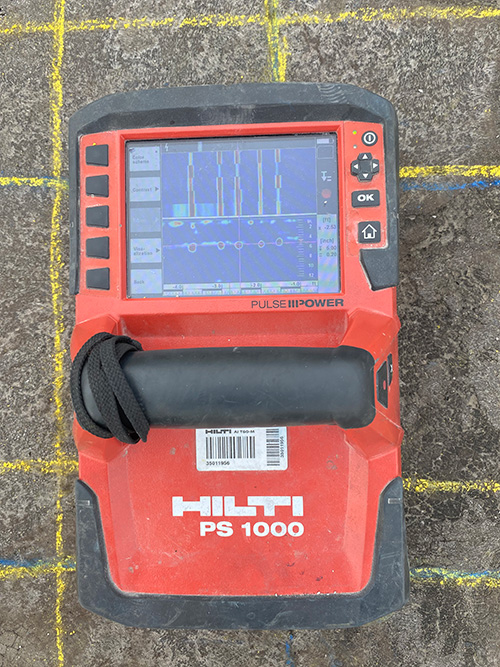Elevate Your Building Process With the Strategic Insights of Concrete Scanning for Enhanced Performance
In the world of modern-day construction techniques, the quest for performance and precision is critical. Embracing innovative modern technologies has actually come to be a cornerstone for accomplishing these objectives. One such technology that has actually transformed the construction sector is concrete scanning. By taking advantage of the calculated insights supplied by concrete scanning, construction experts can unlock a realm of improved performance and streamlined processes. The effects of integrating concrete scanning go much beyond surface-level benefits, using an extensive effect on task results.

Benefits of Concrete Scanning
Enhancing project effectiveness and safety and security, concrete scanning provides a non-destructive approach for finding surprise things within concrete frameworks. By using technologies such as ground-penetrating radar (GPR) and concrete x-ray imaging, building and construction groups can properly situate rebar, post-tension wires, electric channels, and other blockages prior to boring, cutting, or coring into concrete.
The benefits of concrete scanning are various. It decreases the danger of unintentional damage to crucial structural components, minimizing the possibility of expensive repairs and task delays. Secondly, it boosts worker safety by giving real-time insights into the location of surprise risks. Construction websites can be complicated settings, and understanding what exists below the surface can avoid mishaps and injuries.
Additionally, concrete scanning promotes total project effectiveness by preventing and enhancing operations rework. By identifying prospective concerns at an early stage, groups can adjust their strategies proactively, saving time and resources over time. In essence, the adoption of concrete scanning modern technologies is a strategic investment that pays dividends in regards to efficiency, cost-effectiveness, and security.
Modern Technology Assimilation for Performance
Concrete scanning's capacity to streamline workflows and enhance project performance can be further optimized through tactical combination of advanced technologies. By incorporating Structure Information Modeling (BIM) software application into concrete scanning processes, construction groups can accomplish a greater degree of accuracy and control. BIM enables the production of 3D versions that supply in-depth understandings into the project, making it possible for much better decision-making and minimizing the chance of errors. Additionally, the assimilation of Augmented Reality (AR) modern technology with concrete scanning can improve on-site visualization, allowing project supervisors and employees to overlay digital information onto the physical setting in genuine time. This can assist in extra exact positioning of elements and boost interaction among team participants. The usage of drones for aerial studies in conjunction with concrete scanning can expedite data collection and evaluation, enabling much faster decision-making and development monitoring. In general, the critical integration of these innovations can substantially enhance performance and productivity in building and construction jobs.
Preventing Pricey Errors
Just how can careful interest to information during concrete scanning procedures aid building teams in avoiding pricey errors? By using sophisticated scanning technologies such as Ground Penetrating Radar (GPR) and electromagnetic induction, building teams can precisely detect rebar, utilities, spaces, and other blockages within concrete frameworks. Additionally, concrete scanning assists in ensuring architectural honesty by identifying weaknesses or issues in the concrete very early on, permitting for prompt repair visit the website work and adjustments.
Enhancing Job Management
Thorough attention to information throughout concrete scanning processes not only helps in avoiding expensive mistakes however additionally lays a strong structure for effective project management in building ventures. By including concrete scanning technology into project management methods, building and construction groups can simplify operations, enhance communication, and guarantee that projects stay on track.
Concrete scanning provides important insights right into the architectural stability of existing elements, permitting job managers to make informed decisions pertaining to style adjustments or building series. This proactive approach decreases the threat of unforeseen hold-ups or revamp, eventually saving time and sources. Additionally, the data obtained from concrete scanning can be integrated right into Building Info Modeling (BIM) platforms, enabling real-time cooperation and sychronisation among various stakeholders.
Moreover, concrete scanning aids project supervisors determine potential hazards or challenges prior to they intensify into bigger problems, advertising a more secure job environment for all included. With boosted presence and accuracy offered by concrete scanning modern technology, job managers can effectively intend, monitor, and implement building and construction jobs with greater effectiveness and self-confidence.
Maximizing Performance
One key aspect of making best use of efficiency is with the adoption of concrete scanning modern technology. By using ground-penetrating radar (GPR) and other scanning methods, building groups can accurately find rebar, channels, and other subsurface aspects, reducing the danger of expensive mistakes and hold-ups during excavation and drilling.
In addition, welcoming Structure Details Modeling (BIM) software application can dramatically improve performance by producing thorough 3D versions that boost job visualization and sychronisation amongst different professions. BIM permits better clash discovery, allowing concerns to be determined and fixed prior to building even begins, conserving time and resources in the long run.
Implementing a lean building and construction strategy, which concentrates on removing waste and enhancing efficiency throughout all job phases, is an additional efficient technique for optimizing productivity. By promoting collaboration, interaction, and constant renovation, construction teams can function more cohesively in the direction of achieving project objectives in a efficient and streamlined fashion.
Verdict
In final thought, the calculated application of concrete scanning in the building and more tips here construction process uses numerous advantages, including boosted performance, cost savings, boosted job management, and boosted productivity. By integrating this modern technology, building groups can stay clear of costly mistakes, streamline their operations, and maximize their general project outcome. Concrete scanning is a valuable tool that can raise the building process and result in more effective and profitable end results.
